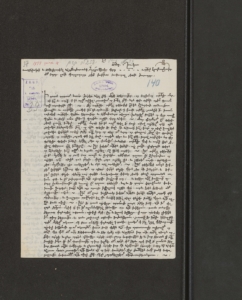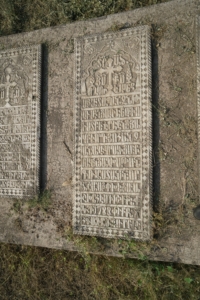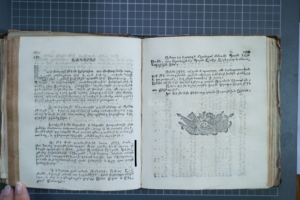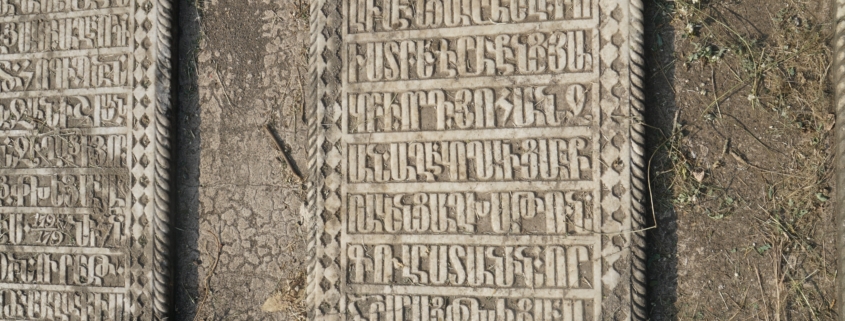“As an Owl amidst the ruins”: A Note on Agha Jacob Hovanjan Guerak-Mirman of Surat
September 15, 2018
Yesterday evening, I came across a letter while digitally “sifting” through reproduction of documents I acquired last summer from the Catholicosate archives at the Matenadaran in Yerevan. Stored in folder 258, the letter in question was written by a Julfa merchant who first caught my attention nearly twenty years ago when I initially became interested in the workings of patronage for cultural and literary works, chiefly in its avatar of print culture, by Julfa merchants residing in India. The name of my letter writer is Աղա Յակոբ Յովանջան Գէրաքէնց or Agha Jacob Hovanjan [anglified as Owenjohn] of the Guerak-Mirman family of Julfa. Incorrectly dated as being sent in 1799, this letter was written at a particularly somber juncture in this millionaire’s life and in the immediate wake of his wife’s passing. I read the letter at a cafe yesterday and was immediately touched by his poetic tone born of melancholia and mourning. Until yesterday, Owenjohn Jacob was for me only a representative of what Max Weber called a “social type,” a diaspora benefactor or patron of Armenian cultural and educational enterprises who always stepped in to bankroll Armenian schools, printing presses, and churches in the absence of Armenian states or landed nobility. Granted, Owenjohn Jacob towered above most others because he hailed from a lineage as close to aristocracy as any Armenian family was likely to come (See my entry from about a month ago on the Guerak-Mirman family of Venice and of Gregorio di Guerak-Mirman, the Italianized and Catholic relative of Owenjohn in Surat). His act of patronage that made him a representative of a social type came at a time when a wave of diaspora patriotism and patronage swept over the Armenian communities in India and galvanized rich and poor alike around the cause of financially assisting the newly built (1779) Armenian diaspora colony of Nor Nakhijevan (now Rostov Na Donu Росто́в-на-Дону́) composed of Armenian refugees from the Crimea who themselves were descendants of a diasporan population that had fled their homeland during the Seljuk followed by Mongol conquests of the eleventh and thirteenth centuries, respectively. Several wealthy Armenians left significant sums for Nor Nakhijevan, at a time when print culture and the long-distance networking spearheaded by Archbishop Joseph Arghut‘eants‘ (the founder of Nor Nakhijevan, see image 5) was facilitating “nation-building” across the diaspora. Abdelmassey Babajan of Calcutta left 100,000 rupees in his will (see image 6), the opium king of Macau, Joannes Matteus, also bequeathed huge fortunes. However, none came close to our man whom Mesrob Seth in his characteristically Victorian-slanted English prose has rightly described as “the Nestor of the Surat Armenians who was piety personified.” (Seth, 253 and 250). Owenjohn Jacob Guerak left his entire fortune estimated at an astronomical 350,000 rupees for the benefit of endowing two schools and a printing press in the newly founded Armenian colony on the River Don and the Black Sea.
After I read Owenjohn Jacob describe his descent into darkness and depression in his letter to Catholicos Ghukas Karnets‘i, I thought to myself, “who said merchants and benefactors were incapable of experiencing and voicing poetic insight?” Below, is a transcription and translation of the passage that moved me, followed by the fruits of a little sleuthing around in my digital archives.
Document 1: Letter to the Catholicos Ghukas Karnetsi by Ohanjan Hakopean Guerakeants of Surat also known as Owenjohn di Jacob Guerak-Mirman of Surat dated 1238 [SIC, the correct date should be 1228 or 1789] (1789) June 21. Matenadaran Catholicosate archives 258, #39

Letter of Letter to the Catholicos Ghukas Karnetsi by Ohanjan Hakopean Guerakeants of Surat, source: Katoghiokosakan Divan, 258.
……Եւ թէ դառն ողորմելոյս տրտմութեան լուրն խաթիր խասանի [بخاطر آوردن] Ա[ստուա]ծ իմ մեղացն բ[ա]րկ[ա]ց[ա]ւ. մայիսի ե [5]. ին իմ աղաւնակենց[ա]ղ կենակիցս առ Ա[ստուա]ծ փոխեցաւ, տունս քանդվեց ծերուտ միայնացե[ա]լ ագռաւ ող[ո]րմելի մն[ա]ցի. վայ եւ եղուկ եղկելոյս. զի արդ պ[ա]տմեցից զկսկիծն իմ. տկար ծերրութ[եան]ս. եւ տանս յօվուողն օգնակ[ա]նս բաժանվեցաւ. յուսօվի թէ կտ[ա]կիս կատարող գնի. այժմ մն[ա]ցէլ[ե]մ անյուս ո[ր]պ[էս] բու աւերակի միայնացեալ ՚ի տանիս. չունեմ մի ինչ նշոյլ մխիթարութ[եան] ողորմելի կսկծմամբ օր ամ անցուցն[ա]մ. փառք բար[ե]ր[ա]ր մեծին Ա[ստուծո]յ.
…թվին առբճլթը [1238] յունիսի իա սուրաթումս
Տրտում անմխիթար փոքր ծառայ յոհանջան յակոբեան գէրաքեանց
“If you were to recall the melancholic news of this pitiful one, God was angered by my sins [and] on 5 May, my dove-like wife passed away, and my home was undone. Now I have remained an old and solitary raven. Woe be unto me, for I shall tell you [below] of my fear of old age. The shepherd of my home and my helper has been taken from me. I am hopeful that there will be someone who will execute my last will and testament. I am now left bereft of any hope, as lonely in [my] home as an owl amidst ruins. I have not a glimmer of consolation left; I spend my days with pitiful fear. Glory be to God the beneficent.”
The dove-like wife alluded to with so much pathos here but not named bore the name Gulistan. Her tombstone is in a small plot at the Armenian cemetery of Surat right next to that of her husband’s. She predeceased him by seven years. Here is Seth’s slightly inaccurate translation into English along with my own transcription in original Armenian script and new translation.
“This is the tomb of the chaste lady Goolistan, the daughter of Arrakiel of the Gentloom family and the wife of Agah Owenjohn, the son of Jacob of the Gerakheantz family who departed from this world on Friday, the 16th day of Adam [17th May [SIC!]] in the year of our Saviour, 1788, and in the year 173 of the small era, aged 58 years.” (Seth, 255)
 My transcription (see image 2):
My transcription (see image 2):
ՏԷՐ ԱՍՏՈՒԱԾ
ՅԻՍՈՒՍ ՔՐԻՍՏՈՍ
ՈՂՈՐՄԵԱ ՄԵԶ
ԱՅՍ Է ՏԱՊԱՆ ՋՆԹԼՈՒՄԷՆՑ ԱՌԱՔԷԼԻ ԴՈՒՍՏՐ ԵՒ ԳԷՐԱՔԷՆՑ ՅԱԿՈԲԻ ՈՐԴԻ ՅՈՀԱՆՋԱՆ ԱՂԷ ԿՈՂԱԿԻՑ ՄԱՔՐԱԿԵՆՑԱՂ ԽԱԹՈՒՆ ԳՈՒԼԸՍՏԱՆԻՆ ՈՐ ԾԸ [58] ԱՄԱՑ ՓՈԽԵՑԱՒ ԱՇԽԱՐՀԷՍ Ի ԹԻՎՆ ՓՐԿՉԻ[Ն] 1788 ՓՈՔՐՆ ՃՀԳ [173+1615=1788] ԱԴԱՄ ԺԶ [16] ՈՒՐԲԱԹ։
THIS IS THE TOMB OF AUSTERE LADY GULISTAN THE DAUGHTER OF ARAKEL OF THE GENTLUMENTS‘ FAMILY AND WIFE OF HOVANJAN [OWENJOHN] AGHA SON OF HAKOB [JACOB] OF THE GUERAKENTS‘ FAMILY WHO DEPARTED THIS WORLD AT THE AGE OF 58 IN THE YEAR OF THE SAVIOR 1788 ON ADAM 16 [MAY 5] IN THE SMALL CALENDAR OF 173 [173+1615=1788] ON FRIDAY.
Her heart-broken “Nestor” was buried next to her.
 ՏԷՐ ԱՍՏՈՒԱԾ
ՏԷՐ ԱՍՏՈՒԱԾ
ՅԻՍՈՒՍ ՔՐԻՍՏՈՍ
ՈՂՈՐՄԵԱ ՄԵԶ
ԱՅՍ Է ՏԱՊԱՆ ԳԵՌԱՔԷՆՑ
ՀԱՆԳՈՒՑԵԱԼ ՅԱԿՈԲԻ ԱՂԷ ՈՐԴԻ ՈՂՈՐՄԱԾ ՀՈԳԻ ՊԱՐՈՆ
ՅՈՀԱՆՋԱՆ ԻՇԽԱՆ
ԱՂԱՅԻՆ ՋՈԻՂԱՅԻՑ ՈՐ
72 ԱՄԱՑ ՓՈԽԵՑԱՒ
ԱՇԽԱՐՀԷՍ 1795 179 ՆԻՐՀԱՆ
10ԻՆ ՕՐՆ ՈՒՐԲԱԹ
ՍՈՒՐԱԹ ՔԱՂԱՔԻՍ
MAY THE LORD GOD JESUS CHRIST
HAVE MERCY ON US
THIS IS THE TOMB OF THE LATE PRINCE HOVANJAN SON OF JACOB AGHA OF THE GUERAKENTS
FAMILY WHO PASSED FROM THIS WORLD
AT THE AGE OF 72 IN 1795/179 ON 10 NIRHAN [FEBRUARY 23] ON FRIDAY IN THIS CITY OF SURAT.
His death in 1795 was significant enough to be mentioned in Madras’s Armenian newspaper, an excerpt and translation (see image 4) I am also providing below:
Announcement of the death of Owenjohn Guerak-Mirman’s death in Surat on 9 Nirhan 9, 22 February, 1795)
«Ոչ թէ միայն տրտմութիւն է հասու լինիլ ժամակէս [sic] նուազ կացութիւնն ազգիս մերոյ յաւել եւս է ողբալ զի ծերքն պակասին ՚ի մէնջ, քանզի Յովանջան Ամիրայն Գէրաքեանց վախճանեալ է ՚ի Սուրաթ, ՚ի 9երրորդ նիրհան ամսոյն գրեն թէ ստացուածն նորա է 350000 ռուփի, զոր ՚ի կենդանութեանն իւր նշանաւորեալ է վասն վանօրէից եւ այլոց ըստ բարի կամաց իւրոց: (Azdarar, month of Nirhan 1795, page 151).
“ Not only is it melancholic [trtmut‘iwn] to be aware of the present weakened state of our nation, it is even more sorrowful [to learn] that the elders among us are getting fewer. Hovanjan Amira Guerakeants‘ has passed away in Surat on the 9th day of the month of Nirhan [22 February]. They write that his estate was worth 350,000 rupees, which according to his good wishes, was designated for monasteries and other [charities] while he was alive.
Not only is it melancholic [trtmut‘iwn] to be aware of the present weakened state of our nation, it is even more sorrowful [to learn] that the elders among us are getting fewer. Hovanjan Amira Guerakeants‘ has passed away in Surat on the 9th day of the month of Nirhan [22 February]. They write that his estate was worth 350,000 rupees, which according to his good wishes, was designated for monasteries and other [charities] while he was alive.





